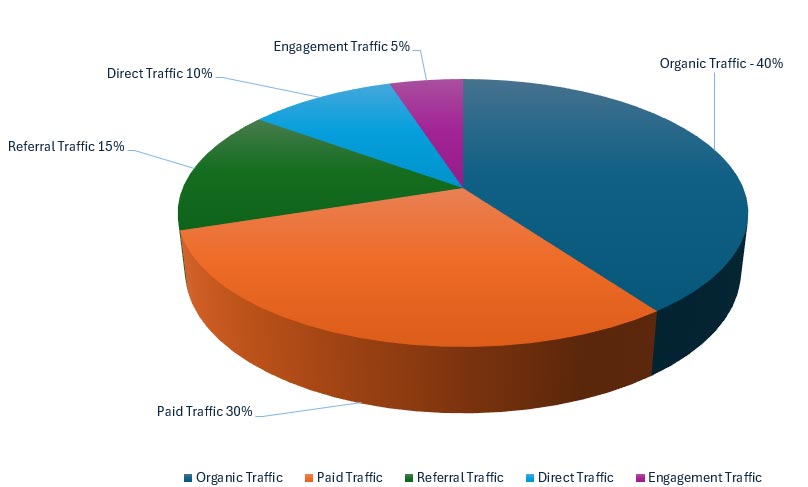Driving relevant traffic to your website is often the missing link for businesses with good websites that just don’t seem to deliver enough leads. If you’re asking, “How can I drive traffic to my website?” you’re already on the right track. You recognise the importance of web traffic growth, but you may not be aware of the various channels that can bring in traffic - or how to maximise each one.
In this post, we’ll explore the types of traffic a typical B2B website can receive, how to strategically grow those traffic sources, and why content creation plays a pivotal role.

The Five Types of Website Traffic
Not all visitors are created equal. Knowing the different traffic types will help you focus your efforts on what works best for your business:

Organic Traffic (40%)
Organic traffic comes from search engines like Google or Bing. Visitors find your site through non-paid search results, often by searching for questions, solutions, or services related to what you offer.
To grow this traffic:
- Ensure your website is optimised for search engines (SEO).
- Use keyword research to create content that matches what your audience is searching for.
- Focus on cornerstone content like case studies, whitepapers, or in-depth guides that showcase your expertise.
Pro Tip: Make use of your blog to answer questions your audience is asking. Regularly posting articles targeting high-intent search terms is one of the best ways to increase organic traffic.
Note: You want long term organic growth - this is the one to focus on.
Paid Traffic (30%)
Paid traffic comes from running ad campaigns on platforms like Google Ads, Microsoft Ads, or LinkedIn. These campaigns can target specific keywords, audiences, or locations, making them highly effective for quick wins.
To grow this traffic:
- Use Performance Max campaigns for holistic Google Ads targeting.
- Combine paid ads with remarketing to re-engage visitors who’ve already been on your site.
- Allocate budget to high-conversion pages or services, like a lead magnet or detailed service description.
Pro Tip: Ensure your ads lead to relevant, high-quality landing pages that convert.
Referral Traffic (15%)
Referral traffic comes from links on other websites. These could be blogs, directories, partner sites, or even social media.
To grow this traffic:
- Focus on acquiring high-quality backlinks from trusted sources in your industry.
- Collaborate with other businesses for guest blogging opportunities.
- Use directories like local business listings to enhance visibility.
Pro Tip: When pitching guest blog posts, suggest topics that showcase your unique expertise and provide value to their audience.
Direct Traffic (10%)
Direct traffic comes from people typing your website URL directly into their browser. It reflects how well-known your brand is.
To grow this traffic:
- Invest in brand-building activities, like webinars, events, or social media campaigns.
- Use memorable, consistent branding across all your marketing efforts.
- Encourage your team to include your website URL in email signatures and printed materials.
Engagement-Driven Traffic (5%)
Engagement-driven traffic includes visits from email marketing campaigns, social media posts, and even podcasts.
To grow this traffic:
- Share blog posts and content updates regularly on social media.
- Leverage email marketing with targeted campaigns, such as drip sequences or newsletters.
- Consider producing engaging formats like videos or podcasts to expand your audience.
Pro Tip: Use engagement tools like polls or questions on social media to drive clicks back to your website.

The Power of Content Creation
No matter what traffic source you focus on, content creation is the foundation of a strong traffic strategy. Content answers your audience’s questions, builds trust, and encourages them to explore your website further with Bronze, Silver, and Gold Content Tiers.
- Bronze: Blog posts and FAQs that address common questions in your industry.
- Silver: Whitepapers, in-depth guides, and how-to articles.
- Gold: Case studies and success stories that showcase how your services solve real problems.
The more value you provide, the more likely visitors are to trust your expertise and take action - whether that’s contacting you, downloading a resource, or signing up for your services.

Bringing It All Together
Driving traffic to your website is about combining multiple strategies and channels, each playing its part. The key is to balance quick wins like paid traffic with long-term efforts like SEO and content creation.
If your website isn’t generating the traffic it should, ask yourself:
- Are you creating enough content to attract organic traffic?
- Are you leveraging paid campaigns to supplement your efforts?
- Are you nurturing visitors through email and social media?

FAQ
1. How long does it take to see results?
SEO and organic traffic growth can take months, while paid campaigns deliver results almost immediately. For best results, combine both.
2. What’s the best traffic source to focus on first?
Start with organic traffic by optimising your website and posting content, then layer in paid ads to amplify your reach.
3. Can I handle this myself, or do I need help?
If you’re new to digital marketing, it’s worth consulting experts who can help you develop a strategy tailored to your business.
Disclaimer:
These percentages are based on typical benchmarks for B2B websites but can vary widely depending on your industry, business goals, and marketing strategy. Use this as a guideline to identify areas of focus for driving relevant traffic to your site. Every business is unique, and it's essential to tailor your approach to suit your specific needs and audience.

Author
Technical Director
With over 20 years of experience in building and promoting websites, Neil is a seasoned expert in digital marketing and SEO. Passionate about helping businesses grow through innovative web solutions, Neil has successfully built over 400 websites.

